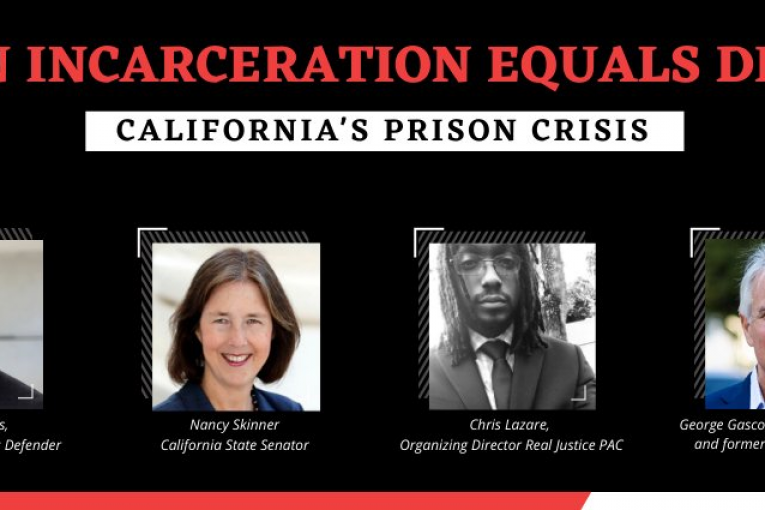
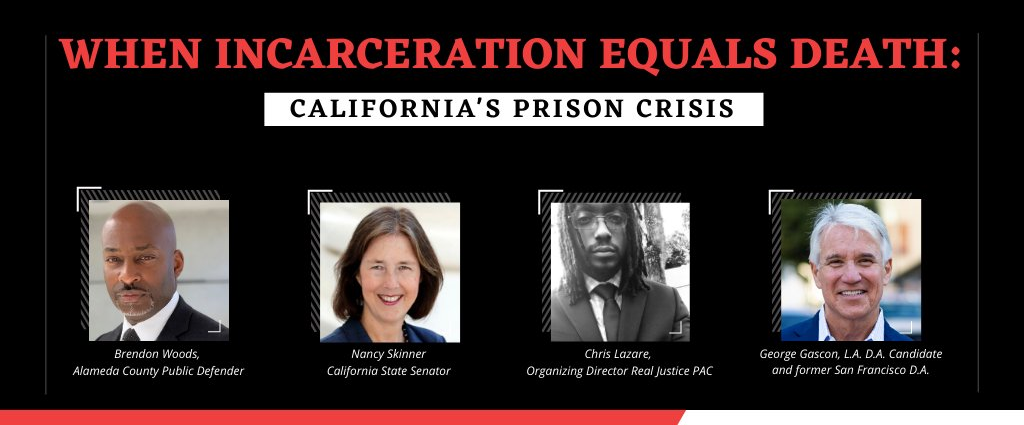
While concerns about the conditions of prisons and jails were aired prior to the current pandemic, COVID-19 has raised those stakes to the potential that even a minor arrest or incarceration will lead to death in California’s jails and prison.
On Wednesday the Real Justice Pac, and host Chris Lazare, held a webinar featuring State Senator Nancy Skinner, Alameda Public Defender Brendon Woods and George Gascón, former San Francisco DA and current candidate  for DA in Los Angeles.
for DA in Los Angeles.
With attention focused on the death of George Floyd, protests and the riots, the discussion started there.
Brendon Woods argued there was nothing new about the police violence: “It always has occurred and the only difference now is it’s on Facebook and it’s on Twitter. The national outrage around police brutality is necessary.”
He added, “If we want to fix the problem, we have to expand it beyond police brutality lens and get to the real heart of the matter which is systemic racism that occurs in each and every segment of society.”
Senator Nancy Skinner, who represents Berkeley and part of Oakland, noted the huge amount of money that we are currently spending on incarceration.
She noted, in the budget crisis, California is making huge cuts.
But she said, “Our corrections budget, which is our prison budget, even with this big drop in revenue, will, if we adopt it as proposed, will be less than one percent reduction from what we spent last year. So it will be $17.4 billion and maybe we spent $17.6 last year.”
Every other budget, she said—“the cuts range from minimum five percent upwards to 40 percent.”
Why? She said “systemic and structural racism are at the core of much of it.”
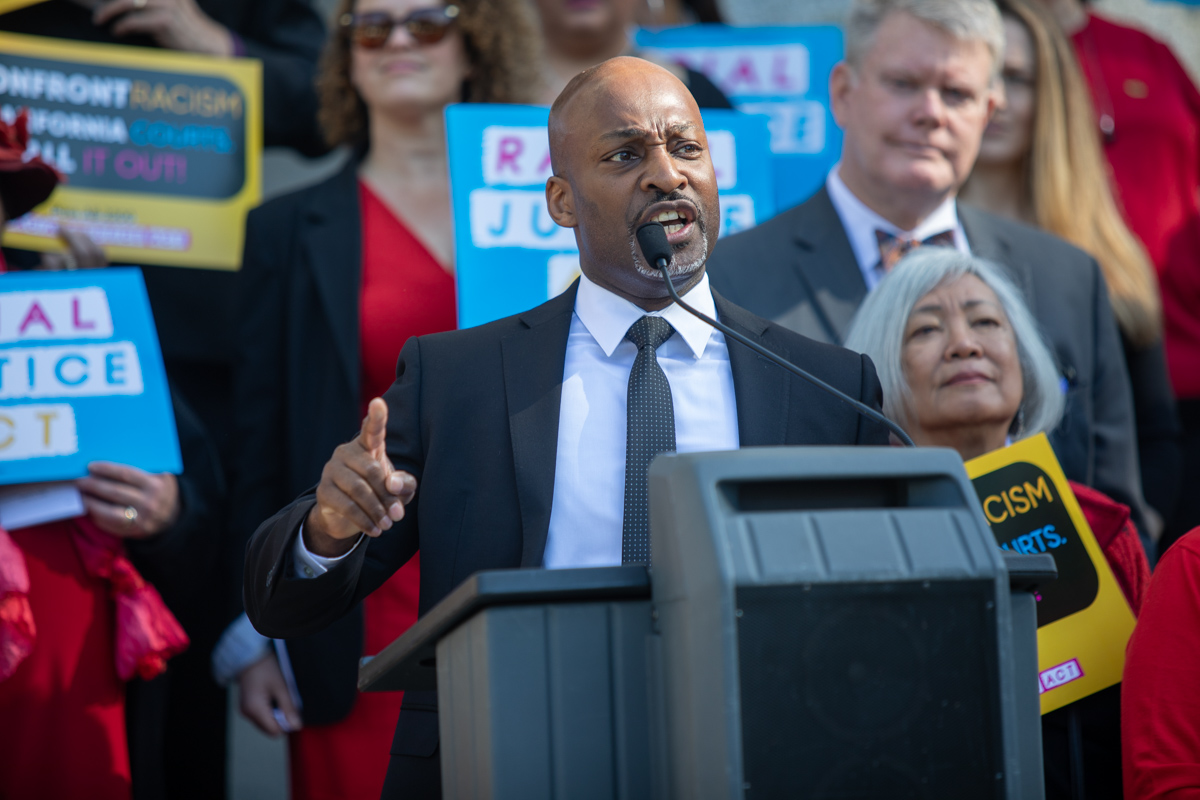
She said if you “look at the code words, the code language we use around public safety are to inspire fear in white people, are a kind of coded language around crime and around violence.” She said, “Then we know who gets stopped, who gets arrested, who gets convicted.”
Senator Skinner added, “I hope we can use this painful moment of confronting the police brutality to understand its layers.”
George Gascón agreed: “The problem of racism in this country is systemic and certainly impacts almost every walk of life.”
He added, “We have an opportunity today to perhaps address police violence and address a lot of the systemic problems that we have in the criminal justice system in hopefully a better way than we have in the past.”
A big question that Chris Lazare raised was what the connection is between the COVID crisis and the marchers—and for the panelists, the answer was clearly the injustice and the brokenness of the system.
Gascón noted that even with the reforms which have been implemented, the system remains broken.
“We are prosecuting too many people and usually, almost always people of color,” he said. “Sometimes even before you’re proven guilty you are already almost given a death sentence.”
He added that what has been ignored so far are the public health concerns. “Not only are the people incarcerated being impacted,” but the people who work around the jails and prisons “are bringing stuff back to the community.”
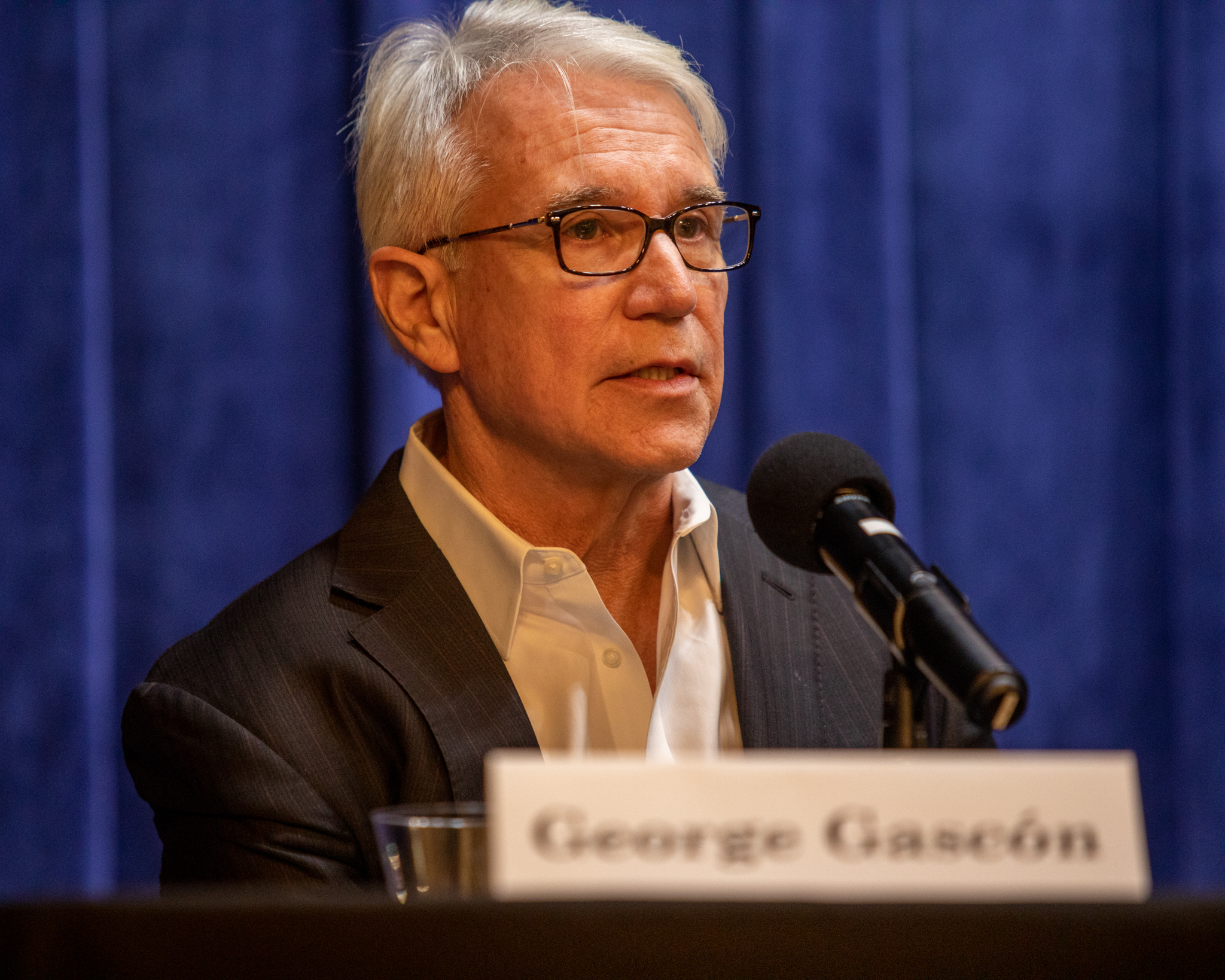
“We’re seeing a complete disregard for the obvious, which is we have a pandemic and public health needs to be at the top priority here. We still have the criminal justice system not getting the message.”
Brendon Woods added there is a clear link between the two. “People of color make up 30 percent of the population in the United States, they make up 60 percent of the incarcerated population,” he said. “Ten percent of black men are behind bars right now. Absolutely it’s related.”
He added, “Think about the impacts COVID is having on the black community—systemic racism in health care, systemic racism in the criminal justice system, it is all intertwined.
“When you sentence black and brown people to jail, when there is a national pandemic, and they are in there for nonviolent offenses, they are going to die, we’ve see that happen,” he said.
Senator Nancy Skinner pointed out that prisons and jails are among the largest remaining congregate facilities. There have not been that many deaths to date, but the concentration of cases is there.
Jails and prisons have the potential to spread COVID like wildfire, she said, and this brings a risk of spreading it throughout the community.
She noted that the staff personnel are actually the ones bringing it to the facilities because, while the incarcerated are locked down and isolated from their families, “the staff is still coming in and out and they’re bringing the virus.”
She said, “So any congregate facility with this virus puts everyone at risk in California.”
But the core issue is why are there so many people in California prisons to begin with.
George Gascón said, “We went into a incarceration binge in this country around 30 years ago. The more that we did, the more that we liked it and we did more and more. We led the way as a state.”
For Brendon Woods, the answer was simple: power, money, racism, and fear.
“The fear that we see is fear of black people,” he said. “That’s what generates all of it.
“There is this narrative perpetrated by law enforcement about black people and crime,” he said. “How people are dangerous. How black people are criminals. How black people are suspects.”
He said, “As a black person, it is much much more dangerous to be a black person.”
Woods noted that police and the government, and also civilians, “hunt us,” referencing the case of Ahmaud Arbery for example.
Picking up on that, Senator Skinner said, “Look at how (President Trump) uses this language.” She said, “Look at how he invokes all of the code language and sends his base out to, in effect, hunt black people down. To guarantee that black people are stripped of all rights.”
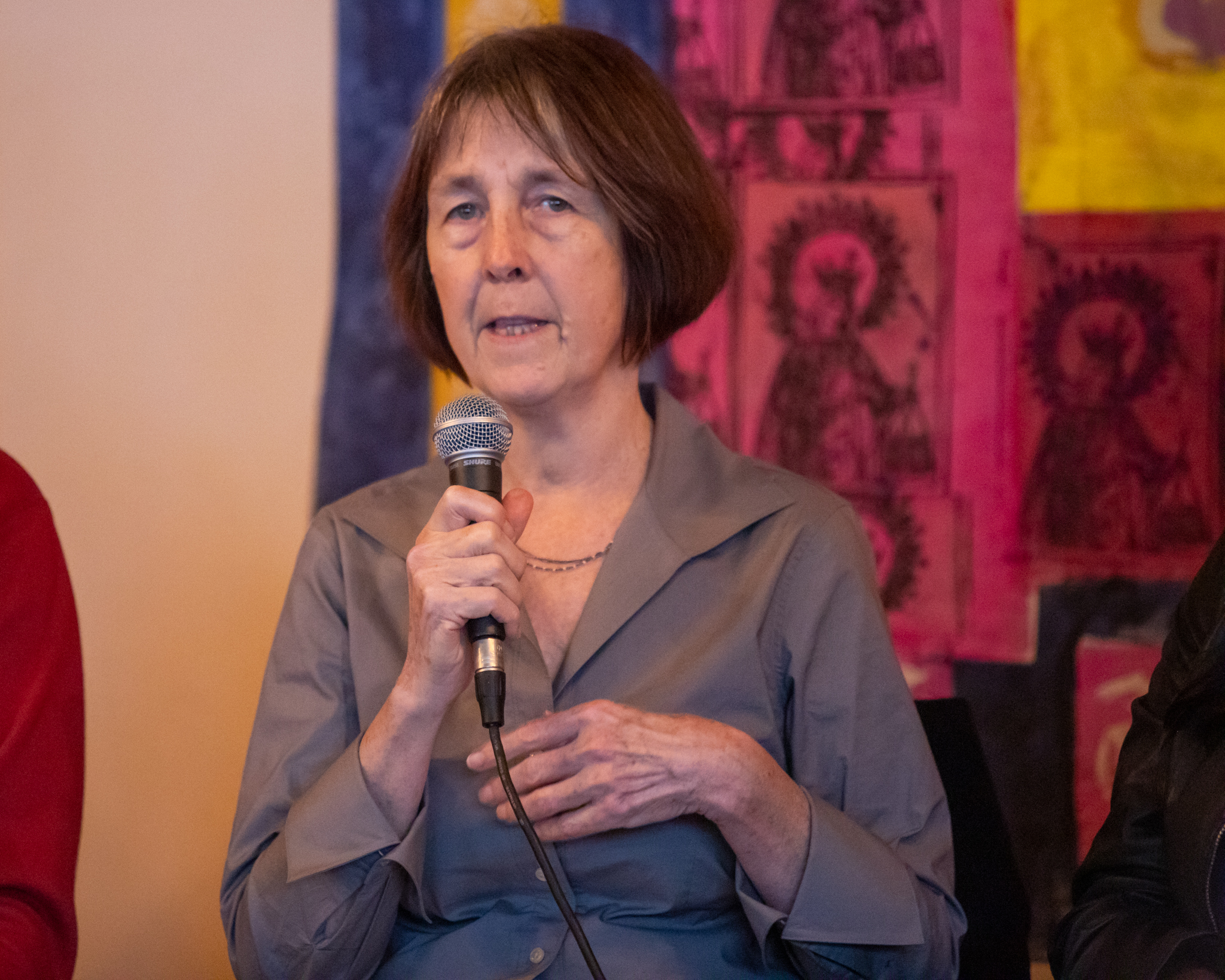
She noted the evolution of this from the “lock them up laws” of President Nixon in the early 70s and the “safe neighborhoods code.”
But George Gascón noted that just because we have locked up more people, it has not made us safer.
To reference this point, he noted in 2012 Prop 36 passed, amending three strikes. At that time, there were thousands of people who were doing 25 to life.
“They were in most counties released within a period of time,” he said. “The recidivism rate for the people released under Prop 36—under two percent.”
He noted Prop 47 was passed in 2014 and that took incarceration from 170,000 to 130,000 in the state.
“Crime did not go up,” he said.
COVID has led to the release of many throughout the state, he said, “not enough,” but a lot of people. “We have released a lot of people and crime hasn’t gone up.”
He said, “We have been incarcerating beyond any return on investment.”
But, as Brendon Woods argued, what has been done has not been enough, “hell no.”
“Thirty-five hundred may seem like a lot,” he said. “But when you consider the entire prison population, that’s 2.9 percent.”
He noted, at the county jail level, they are releasing people with six months left to serve. But they are only talking about 60 days at the prison level.
“Come on, really,” he said. “At a bare minimum, if we are going to have a real conversation, we have to start with a year.”
He said, “If they have a year left to serve, get them out.”
Nancy Skinner spoke about her legislation that would knock parole down from three years to two years.
She said, “Many people who have served 15 to 20 years already are no threat to society if they are released.” She added that there really is no need for a third year of parole, and statistics say that those who are going to go back into a life of crime do it almost immediately. “If a person exhibits significant criminal behavior, they do so right away.”
—David M. Greenwald reporting
To sign up for our new newsletter – Everyday Injustice – https://tinyurl.com/yyultcf9


Tracy McCray is a San Francisco Police Lieutenant who explains why crime numbers don’t show an increase. Crime is still rampant it just doesn’t get reported like before because of Prop 47. Justice reformers want you to believe otherwise. She starts speaking at the two minute mark but the entire video is enlightening.
https://news.yahoo.com/american-dystopia-san-francisco-decline-013738753.html
One way to disprove her narrative is to look at a stat that wouldn’t be impacted by 47 – murder rate. It’s at historical lows. That’s an indicator that crime is down.
Sorry, but the two don’t equate. Apples to oranges. But nice try at the spin.
https://www.city-journal.org/san-francisco-crime
Focusing on San Francisco alone doesn’t show the whole picture. For instance, using California DOJ data, the Public Policy Institute (https://www.ppic.org/publication/felony-arrests-in-california/) has shown that the proportion of arrests for violent crime is smaller after Prop 47. I’ve asked the Vanguard to post a chart I created using data from the Dept. of Justice. Violent crime and drug crimes have declined significantly since Prop. 47 went into effect. Property crime statewide has seen a smaller decline, but a decline nonetheless. Relying only on SF crime is not a great generalization (which it appears is what you are doing). the PPIC report notes that the highest felony arrest rates are in more rural areas, not the urban centers.
Keith, the devil is always in the details when we talk about crime.
https://sacramento.cbslocal.com/2019/09/25/grab-and-dash-thefts-rise-police-blame-law/
“Crime is rampant”
I believe this may be an example of the “coded” language referenced in the article.
Seriously? Did you watch the lieutenant speak in the video?
Tia, what would be the “coded” language for for a protester yelling in an officer’s face?
“COVID assault” ?
No. It’s a matter of looking at crime trends, murder rates move with crime trends overall. They peaked at the same time and declined in conjunction. Then you look at a crime that is going to be unimpaired by Prop 47 – murder. You can also look at violent crimes and see the same thing. By isolating on a variable you can determine fairly convincingly that crime probably is legitimately going down.
I isolate on a variable every night right before I do my nails.
TMI… but whatever floats your boat…
Since I can’t comment right below Keith’s comment below the chart I posted quoting someone about Vacaville, I’ll do it here.
Of course, local variations exist in crime over time. What is your point here. Better yet, what is your suggested solution to the problem that this cop is alluding to – the law is not a deterrent to crime. Is that a fair statement of what your point is?
I’m sure you will always be able to find statements from cops who will tell you how bad crime is. But of course, they are a biased sample, aren’t they. They live with crime every day, every hour. That’s their business.
I worked in the correctional system for almost 20 years and I used to hear it all the time: “They’re just inmates. They got it comin'” And in truth conditions in prisons and jails are pretty tough for both the inmates/detainees and the people who work there. It can be hard to step back and view it with some dispassion.
I’m a psychologist – a bleeding-hear liberal psychologist to boot. So I have my biases too. But the facts and the data – like in the chart above – don’t really have a bias. They are just data. Crime in the aggregate is down – most types – felonies, drug crimes, and even property crimes. I would argue that Tucker Carlson is not a dispassionate observer, and neither is the lieutenant.
Excuse me, but huh?
So let’s get rid of all corporate and banking law because the law is no deterrent to crime.
It is irrational to believe that incidents of crime fall after releasing prisoners and raising the bar for criminals to be charged and convicted.
From the site quoted:
There is every expectation that the trend line for the increase has continued and probably escalated even as the number of arrests has declined because of the liberal policies to decriminalize property crimes, theft and drug-related crimes.
Jeff,
Maybe I wasn’t very clear. It seems to me that what the lieutenant was saying was – now that the penalties for the crime (larceny of property worth less than $950) has been reduced (no longer a felony with a possible state prison sentence) there is no longer a deterrent effect and thus no reason not to steal (“Why don’t you just give me a ticket?”).
You say: “It is irrational to believe that incidents of crime fall after releasing prisoners and raising the bar for criminals to be charged and convicted.”
But the data from the California DOJ (in the graph) would suggest that that is exactly what has happened in those categories. I will say that the Federal FBI Uniform Crime Reports give a more mixed picture vis a vis crime rate. The general trend in California is down (especially property crimes of all kinds) but some violent crimes went up after 2014 and have begun to decline again.
I’m a little puzzled by your statement that the trend in the proportion of felony arrests is going up when the quoted text clearly states that the trend was positive from 1980 to 2014 and the “dropped to 26% for the next two years.”
Maybe you can clarify.
By the way, I should have specified that the graph I posted earlier today was for males only and from age 18 to 69. Numbers and rates of crimes of all sorts decline dramatically after age 40 but some keep on going.
Given the interest in reforming criminal justice systems from groups such as the Koch Brothers I think it is a bit simplistic to claim that its just liberal policies that account for these changes. As usual, I think the reasons for these big changes that happen over multiple decades eludes simple political labeling.
For those truly concerned/upset/paranoid by covid-19, may I respectfully suggest this…
https://med.stanford.edu/covid19/covid-counter.html
They seek data… data may set you free… or help public health… have been doing it for ~ 2 months now… why I was OK doing a CO trip to visit/help family… despite some posters saying that I now lack all credibility on anything, because they felt I was a “betrayer” of the common good… ~ 14 days later, o instances of Covid in family, friends, businesses that I have interacted with… strongly suspect I was never been exposed… and I was prudent (doing mask thing, mostly doing social distance thing, but still living my life) , but not “hunkered down”… those who hunker down (and/or expect everyone to do so), and those who want everything to go back as it was (and want everyone else to do so), are all flaming idiots, IMHO…
Be prudent, be reasonable, stay sane (be optimistic), and live… pretty sure that will draw attacks from both sides of the current ‘bell curve’, particularly the second or third deviations…
But the Stanford survey is real, daily input… I’ll trust their data, once they have enough… I recommend all participate…